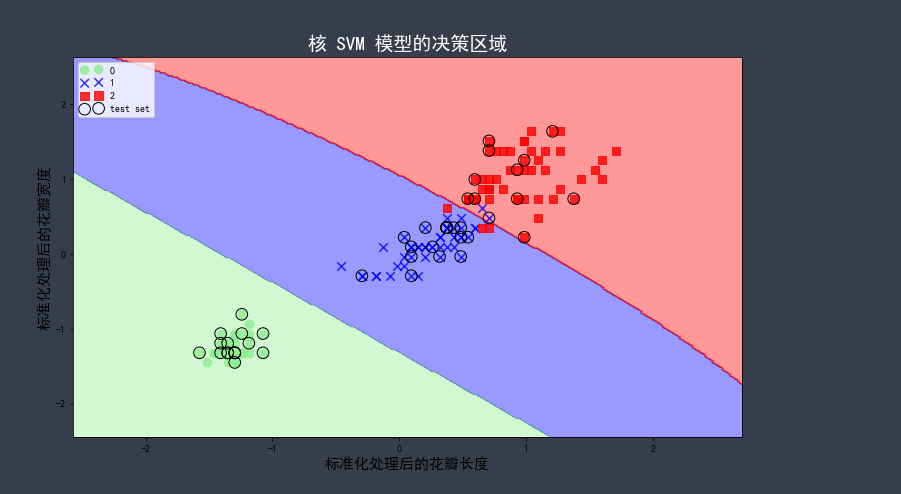iris 数据集训练一个核 SVM 模型,可视化其决策区域
1、定义分类模型决策区域可视化的函数

import numpy as np import matplotlib.pyplot as plt from matplotlib.colors import ListedColormap def plot_decision_regions(X, y, classifier, test_idx=None, resolution=0.02): # 定义颜色和标记符号,通过颜色列图表生成颜色示例图 marker = ('o', 'x', 's', 'v', '^') colors = ('lightgreen', 'blue', 'red', 'cyan', 'gray') cmap = ListedColormap(colors[:len(np.unique(y))]) # 可视化决策边界 x1_min, x1_max = X[:, 0].min() - 1, X[:, 0].max() + 1 x2_min, x2_max = X[:, 1].min() - 1, X[:, 1].max() + 1 xx1, xx2 = np.meshgrid(np.arange(x1_min, x1_max, resolution), np.arange(x2_min, x2_max, resolution)) Z = classifier.predict(np.array([xx1.ravel(), xx2.ravel()]).T) Z = Z.reshape(xx1.shape) plt.contourf(xx1, xx2, Z, alpha=0.4, cmap=cmap) plt.xlim(xx1.min(), xx1.max()) plt.ylim(xx2.min(), xx2.max()) # 绘制所有的样本点 for idx, cl in enumerate(np.unique(y)): plt.scatter(x=X[y == cl, 0], y=X[y == cl, 1], alpha=0.8, c=cmap(idx), marker=marker[idx], s=73, label=cl) # 使用小圆圈高亮显示测试集的样本 if test_idx: X_test, y_test = X[test_idx, :], y[test_idx] plt.scatter(X_test[:, 0], X_test[:, 1], c='', alpha=1.0, linewidth=1, edgecolors='black', marker='o', s=135, label='test set')
2、准备数据

from sklearn import datasets from sklearn.model_selection import train_test_split from sklearn.preprocessing import StandardScaler iris = datasets.load_iris() X = iris.data[:, [2, 3]] y = iris.target # 划分测试集和训练集 X_train, X_test, y_train, y_test = train_test_split( X, y, test_size=0.3, random_state=0) # 对特征值进行标准化 sc = StandardScaler() sc.fit(X_train) X_train_std = sc.transform(X_train) X_test_std = sc.transform(X_test) # 将标准化后的训练数据和测试数据重新整合到一起 X_combined_std = np.vstack((X_train_std, X_test_std)) y_combined = np.hstack((y_train, y_test))
3、训练模型、绘制图形
from sklearn.svm import SVC import matplotlib.pyplot as plt %matplotlib inline plt.rcParams['font.sans-serif'] = 'SimHei' plt.rcParams['axes.unicode_minus'] = False svm = SVC(kernel='rbf', random_state=0, gamma=0.10, C=10.0) svm.fit(X_train_std, y_train) plt.figure(figsize=(12, 7)) plot_decision_regions(X_combined_std, y_combined, classifier=svm, test_idx=range(105, 150)) plt.title('核 SVM 模型的决策区域', fontsize=19, color='w') plt.xlabel('标准化处理后的花瓣长度', fontsize=15) plt.ylabel('标准化处理后的花瓣宽度', fontsize=15) plt.legend(loc=2, scatterpoints=2)
图形如下:

如图所示,γ=0.10 相对角小,决策边界较为宽松。
增大 γ 值:
from sklearn.svm import SVC
import matplotlib.pyplot as plt
%matplotlib inline
plt.rcParams['font.sans-serif'] = 'SimHei'
plt.rcParams['axes.unicode_minus'] = False
svm = SVC(kernel='rbf', random_state=0, gamma=10, C=10.0)
svm.fit(X_train_std, y_train)
plt.figure(figsize=(12, 7))
plot_decision_regions(X_combined_std, y_combined, classifier=svm,
test_idx=range(105, 150))
plt.title('核 SVM 模型的决策区域', fontsize=19, color='w')
plt.xlabel('标准化处理后的花瓣长度', fontsize=15)
plt.ylabel('标准化处理后的花瓣宽度', fontsize=15)
plt.legend(loc=2, scatterpoints=2)
图形如下:

如图所示,类别 0 和 1 的决策边界随 γ 值的增大紧凑了许多。此模型虽然随训练数据拟合的很好,但对未知数据会有较高的泛化误差。
非学无以广才,非志无以成学。





